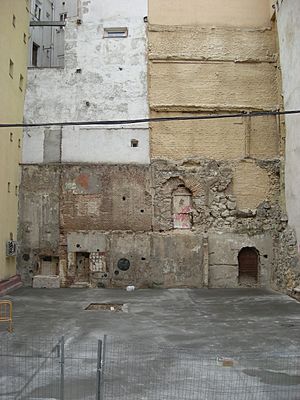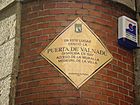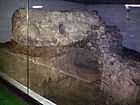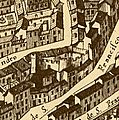Christian Walls of Madrid facts for kids

The Christian Walls of Madrid, also known as the Medieval Walls, were built in Madrid, Spain. They were constructed between the 11th and 12th centuries. This happened after the city became part of the Crown of Castile. These walls were an extension of the older 9th-century Muslim Walls of Madrid. They were needed to protect new areas that grew after the Reconquista (a period when Christian kingdoms took back land from Muslim rule).
When King Philip II moved his royal court to Madrid in 1561, the walls were no longer needed for defense. Most of them were torn down. However, some parts still exist today. You can find them built into various buildings in El Madrid de los Austrias. This is the historic center of the city from the time of the Habsburg kings.
Important parts of the wall can be seen in streets like Mancebos, Don Pedro, Almendro, Escalinata, Espejo, Mesón de Paños, and Cava Baja. You can also find them in Plaza de Isabel II and under the Plaza de Oriente in an underground parking garage. The remaining parts of the walls were officially recognized as a Historical and Artistic Monument in 1954.
Contents
History of Madrid's Christian Walls
Many people believe that King Alfonso VII of León and Castile (who ruled from 1126 to 1157) ordered the building of these walls. But it's likely that construction started even earlier. This would have been soon after Christians took over Madrid in 1083. So, the walls might have begun during the reign of Alfonso VI of León and Castile (1040–1109).
By the early 13th century, the walls were still not finished. A document from 1202, called the Fuero de Madrid, said that money from fines should be used for "the works of the Walls until finished." Other city records suggest they were probably completed by the 1220s.
After the Reconquista ended, in the 14th and 15th centuries, the walls became less important for defense. Madrid grew a lot, and new neighborhoods appeared outside the walls. This led to their demolition, especially after the 16th century. That's when Madrid became the capital of Spain.
Features of the Medieval Walls
The Christian Walls of Madrid protected an area of about 33 hectares (81 acres). Their total length was around 2,200 meters (about 1.4 miles). This protected area was eight times larger than the space inside the older Muslim Walls, which was only about 4 hectares (10 acres).
Unlike the Muslim walls, which had square towers, the Christian walls had semicircular towers. These towers were built on layers of flint stone. Flint creates sparks when hit, which led to a famous saying about the city: "I was on water built, my walls are of fire."
Experts believe there might have been between 130 and 140 towers. They were placed every 10 to 15 meters (33 to 49 feet). The walls also had a moat (a ditch) around most of their outside edge. You can still see where this moat was in the names of some Madrid streets today. These include Cava Alta, Cava Baja, and Cava de San Miguel. These streets were built over the filled-in moat (cava).
The Christian Walls had four main gates. Each gate was protected by strong towers nearby. None of these original gates are still standing today.
- The Puerta de Guadalajara was the city's main gate. It was the most decorated because it was in a busy trading area. It was located where Calle Mayor is today, at number 49. The original gate had two large towers and an arch. In 1535, Emperor Carlos V, Holy Roman Emperor had it replaced with a new, more ornate gate with three arches. This gate was destroyed by a fire in 1582.
- The Valnadú Gate (sometimes spelled Balnadú) was likely located near the Teatro Real. This is where the streets Lepanto, Carlos III, and Vergara meet.
- The Puerta de Moros (the Moorish Gate) was in the south, near the current Plaza del Humilladero. It was between the streets Almendro and Cava Baja. This gate was destroyed in 1412 during a revolt.
- The Puerta Cerrada (Closed Gate) is in the Plaza de Puerta Cerrada. It was first called Puerta de la Culebra (Snake Gate) because it had a dragon carving. It got its new name, "Closed," because it was often shut due to many crimes happening inside. It was next to the Tower del Vinagre. This gate was torn down in 1569. This happened when Elisabeth of Valois, the wife of King Philip II, entered the city.
Besides these gates, three gates from the older Muslim Walls were still used. These were the Arc de Santa María, the Puerta de la Vega, and the Puerta de la Sagra.
Several albarrana towers (towers built outside the main wall) and watchtowers were also built. They were placed in important spots along the walls. One was the Tower de Alzapierna (or de Gaona). Its job was to watch over the Caños del Peral fountain (in today's Plaza de Isabel II). The Tower de los Huesos was built in the 11th century by the Muslims. It was later added to the Christian Walls to protect the Valnadú Gate. You can see its remains in the underground parking lot at the Plaza de Oriente.
Where to See Parts of the Walls Today
The most important parts of the Christian Walls of Madrid are now part of different buildings and city structures. It can be hard to see them because they are often inside private apartment buildings.
- Cava Baja: At number 30 on Cava Baja, a piece of the wall about 20 meters (66 feet) long and 11 meters (36 feet) high is still there. It's in the courtyard of a building. At numbers 22 and 24, you can see a foundation part and the base of a semicircular tower. At number 10, there's a 7-meter (23-foot) long section of wall, 1 to 4 meters (3 to 13 feet) high, next to a tower ruin.
- Calle del Almendro: At number 17, a section 16 meters (52 feet) long and 11 meters (36 feet) wide is preserved. You can see it from the street through a barred door.
- Plaza de Puerta Cerrada: The most complete remaining part of the wall is at numbers 4 and 6. This section is still at its full height. You can even see the old round path (where guards walked) and the parapet (a low protective wall), plus parts of a tower.
- Plaza de Isabel II: At number 3, a part of the wall is in the basement of a restaurant. You can see it during business hours. It was found in 1991 and includes flint stones and two brick arches. These arches were probably added during a later repair. In 1990, the base of the Tower de Alzapierna was found during subway station construction, but these parts were later removed.
- Calle de la Escalinata: Between 1943 and 1945, parts of a tower and wall were found at numbers 9 and 11, near Plaza de Isabel II.
- Calle del Mesón de Paños: At numbers 11, 13, and 15, some poorly preserved remains were found in 1956.
- Calle de los Mancebos: At numbers 3 and 5, you can see the remains of a silo with old Islamic items. It's part of a larger building but visible from the street.
- Calle del Espejo: At number 14, a flint wall 2.5 meters (8 feet) high is inside a garage. You can get to it from Calle de la Escalinata. At number 10, there are also parts of a semicircular tower and wall.
- Plaza de Oriente: The foundation of the Torre de los Huesos is here. This tower was originally Muslim and later became part of the Christian Walls. It is shown in the underground parking lot, which was built in 1996.
Gallery
-
Foundations of the Torre de los Huesos in the underground parking of the Plaza de Oriente. Built of limestone and flint in the 11th century by the Muslim population and subsequently integrated into the Christian Walls.
-
In the plan of Madrid of Pedro Teixeira (1656) some remains of the Christian Walls were noted, such as this fortification located between Calle Almendro and Calle Cava Baja.
See also
 In Spanish: Muralla cristiana de Madrid para niños
In Spanish: Muralla cristiana de Madrid para niños







